In today's lesson, we are going to learn the top 5 guitar chords for beginners. These will help you with writing and learning songs as well as building your guitar chord vocabulary.
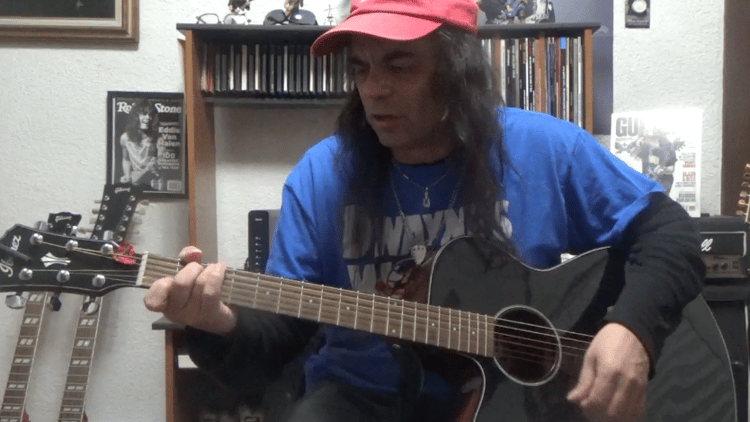
Your first guitar chords
The 5 guitar chords to learn first are the C major, A major, G major, E major, and D major chords. These are often called caged chords. Because the 5 chords spell out that word. To keep things simple in this lesson, we’ll just focus on these 5 chords to get started playing.
Reading guitar chord diagrams
When it comes to playing guitar chords on the guitar, there are thousands, but there is no need to learn that many to start. The 5 most common guitar chords will be just fine.
To learn this more easily, I recommend you learn to read guitar notation. I recommend starting with chord charts. These are diagrams that will help you visualize how these chords are supposed to look on the fretboard.
Chord chart diagram

In this example, the guitar is facing upward, with the low E string (thickest string) on the left. The vertical lines (6 of them) will represent the strings, and the horizontal lines (5 of them) will represent the frets. If you can wrap your head around this musical concept, you'll be able to read any chord formed on the guitar.
Guitar chord example
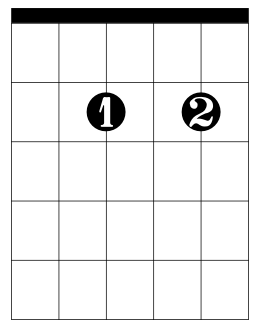
Here, we have the same thing as above, except we have two dots on two strings. This tells us where this chord is on the fretboard and how to form it.
This chord is formed on the 4th and 2nd strings, on the 2nd fret. The numbers within the dots of the diagram tell us which fingers to use to form the chord. Sometimes these numbers will be below the chord.
Master three notes
What is great about these guitar chords we are learning is that they only use three notes. This provides a nice foundation for building upon later. When you’re fingers get used to forming and playing these chords, you simply add notes to change them into other chords.
But for now, just focus on the three notes that these chords are made of. Since there are only three notes, these chords are called triads. A major triad consists of the 1 3 5 of the scale the chord is made of.
Major chord formula
If we look at the notes in the key of C major that the C major chord comes from, we have the notes.
C-D-E-F-G-A-B-C. The root note (C) to its octave (same note above it) has 8 notes.
When we give these notes a number, we see that the C would be 1, the D would be 2, the E would be 3, etc. This lets us know what notes we need to create the C major triad. We will need the
C, E, & G notes. This works with all major chords.
Minor chord formula
This works almost the same way. It has the same three-note chord formula, except you flatten the 3rd note by one fret. With C minor, you now have the chord formula 1, b3, 5. The notes are the same as the major except for the flattened 3rd. The notes for the C minor chord are C, Eb, & G.
Watch the video lesson below
Top 5 chords for beginners:
C major chord

The C major chord is a three-note chord that is built on the 3rd, 2nd, and 1st frets of the fifth, fourth, and second strings. I like to think of this chord as a slanted chord because the notes follow a slanted line.
You place your ring finger on the 3rd fret of the fifth string, your middle finger on the 2nd fret of the fourth string, skip the third string, and place your index finger on the 1st fret of the second string.
A major chord

This chord is three notes built off of the 4th, 4rd, and 2nd strings. All notes reside on the 2nd fret. I call this one a one-fret chord because all the notes line up on the same fret.
Your index finger is placed on the 2nd fret of the fourth string, your middle finger on the 2nd fret of the third string, and your third finger on the 2nd fret of the second string. You can also barre this chord with one finger if it is easier. Watch the video lesson to see different ways to form this chord.
G major chord
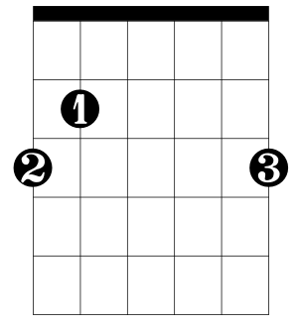
Here we have the G major chord (or G for short) and we can see that it covers the sixth, fifth, and first strings. It is this sixth and first-string stretch that makes this chord a bit difficult at first to learn.
With this chord, you place your middle finger on the 3rd fret sixth string, your index finger on the 2nd fret fifth string, and your ring finger on the 3rd fret first string. There are multiple ways to form the G chord, but this way is the most common, so learn this way first.
E major chord

The E major chord is played on the fifth, fourth, and third strings. At the fourth and second frets. This is a great chord because it is popular in a lot of songs and resides on only two frets.
Your middle finger is placed on the 3rd fret of the fifth string, your ring finger on the 2nd fret fourth string, and your index finger on the 1st fret of the third string.
D major chord

This is a great chord in the fact that it is in the shape of a triangle. Three notes on the third, second, and first strings. It is probably the most popular of all five chords. Here you place your index finger on the 2nd fret third string, your ring finger on the 4th fret of the second string, and your middle finger on the 2nd fret of the first string.
 Why are these chords so popular?
Why are these chords so popular?
The reason why these chords are so popular is that they are very common in many, many songs. What is also great is that the E and the A chords can be substituted for their minor counterpart. The E minor and the A minor. This adds a little shade of color to what you are playing because minor chords sound different than major chords.
Major chords give you an uplifting, happy sound, and minor chords give you a sad sound. Master the 5 major chords, then look into adding the minor chords. This will give you a solid foundation of guitar chords that can serve you well for playing hundreds of songs.
Minor counterpart guitar chords:
E minor chord
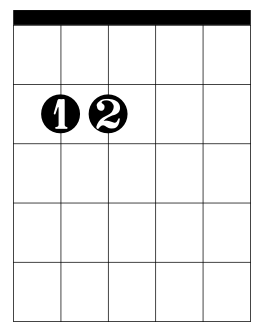
The E minor chord is probably the easiest chord out of all the natural chords to play. Why? Because it only requires two fingers, as you can see from the chord diagram. You just take your index finger off the 1st fret, third string from the E major, and you have the E minor. Very simple and easy to transition from.
A minor chord
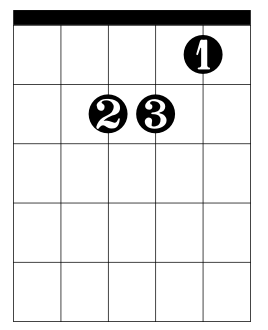
A minor is a great chord as well because if you look at it closely, you can see that it is the same shape as the E major. The only difference is that it is located on the fourth, third, and second strings.
This is a great chord as well because it is an easy transition from the E major. All you need to do is drop all your fingers down a string. This will also give you a different sound than the A major chord.
Dive deeper step-by-step
Keep things simple to start and focus on developing the fundamentals. This will allow you to build a solid foundation. And if more help is needed, I recommend you check out the book I authored and published called;
Learn To Play Electric Guitar
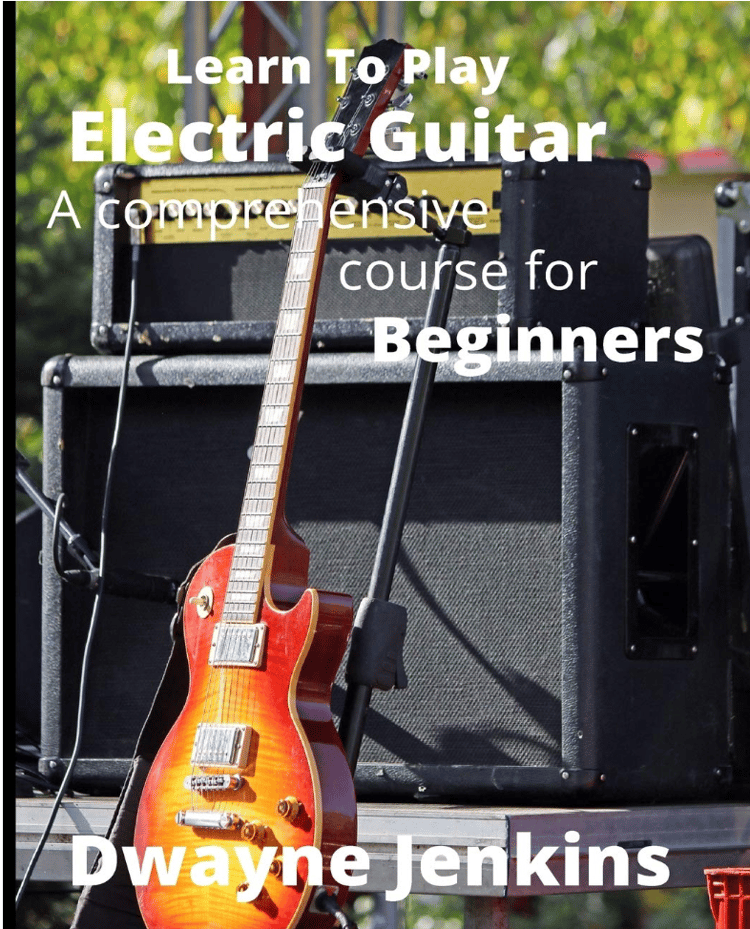
This is written in an easy-to-learn, step-by-step method to get you moving quickly in the desired direction. It is packed with chord diagrams and notation for easy understanding of musical concepts. As well as the opportunity to email me if any help is needed with any of the lessons.
Learn these 5 common chords, as well as the others mentioned in this lesson, and you’ll be able to play hundreds of songs. Of course, you will have to learn how to strum and keep time, but these chords will be a start in the right direction.
Private instruction is also available
I also offer private one-on-one instruction. Customized lesson plans that cater to the student's interest and skill level. All ages are welcome. These are a great way to learn as they provide a better understanding of the concepts and techniques associated with learning to play the guitar. If you feel this moght work for you, just contact me at my website, and we'll set up a time to talk on the phone.
Thank you for your time, and until our next lesson, take care.
Sincerely, Dwayne Jenkins


